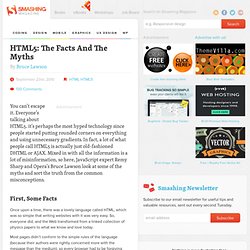

Blog about Technology - Many interesting HTML5. HTML5 Is An Oncoming Train, But Native App Development Is An ... HTML5 versus native apps.

It’s a debate as old as — well, at least three years ago. And pretty much since the beginning of that debate, there has been a general underlying current among the geek community that HTML5 is good and native is bad. Native is what we have to deal with as we wait for HTML5 to prevail. But what if that never happens? Let’s be honest: right now, most HTML-based mobile apps are a joke when compared to their native counterparts. Developers often state their love of HTML5 and their commitment to it going forward. These days, if you’re going to do native apps, you at least have to support iOS and Android. Talking to developers, this is the single biggest pain point on the mobile side of things. But the fact that very few, if any, choose to go HTML5-only is telling.
Let’s look at the debate from the perspective of the three hottest technology companies right now: Apple, Google, and Facebook. Apple is basically all-in on native apps. And that’s not all. HTML5: The Facts And The Myths - Smashing Magazine. Advertisement You can’t escape it.

Everyone’s talking about HTML5. it’s perhaps the most hyped technology since people started putting rounded corners on everything and using unnecessary gradients. In fact, a lot of what people call HTML5 is actually just old-fashioned DHTML or AJAX. Mixed in with all the information is a lot of misinformation, so here, JavaScript expert Remy Sharp and Opera’s Bruce Lawson look at some of the myths and sort the truth from the common misconceptions. First, Some Facts Once upon a time, there was a lovely language called HTML, which was so simple that writing websites with it was very easy. Most pages didn’t conform to the simple rules of the language (because their authors were rightly concerned more with the message than the medium), so every browser had to be forgiving with bad code and do its best to work out what its author wanted to display.
In 1999, the W3C decided to discontinue work on HTML and move the world toward XHTML. The Myths HTML5 Kills XML. HTML5/CSS3 Cheatsheet. Here are some simple cut-and-paste examples of HTML5/CSS3 features that are currently (early 2011) usable across a number of web browsers, chief among them Firefox, Safari, Chrome, Opera and the upcoming IE9.

For many of the CSS3 examples, older versions of Internet Explorer are the lone holdout with a limited number of workarounds, however these features degrade gracefully and may still be useful on new projects as long as this limitation is kept in mind. Please note: With the exception of SVGWeb, no Internet Explorer workarounds have been included on this page - most of the examples will therefore not work in IE6, IE7 or IE8.
And if you want to discuss any of the code below or leave a correction or suggestion, you can leave comments below. Thanks! Updates Rounded Corners Lorem ipsum dolor sit amet, consectetur adipiscing elit. Rounded Corners Redux: Circles Box Shadows Gradients Linear Gradient Angled Linear Gradient Angled Linear Gradient with Color Stops Text Shadows Border Images Column Layout.